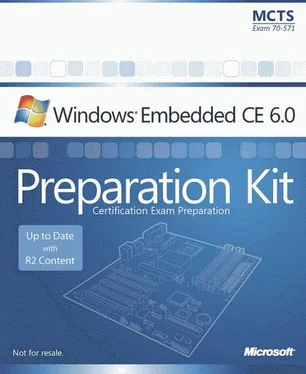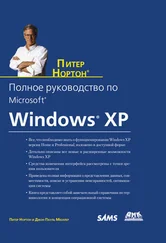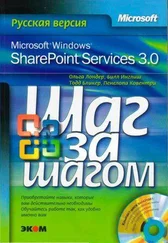Nicolas Besson - Microsoft Windows Embedded CE 6.0 Exam Preparation Kit
Здесь есть возможность читать онлайн «Nicolas Besson - Microsoft Windows Embedded CE 6.0 Exam Preparation Kit» весь текст электронной книги совершенно бесплатно (целиком полную версию без сокращений). В некоторых случаях можно слушать аудио, скачать через торрент в формате fb2 и присутствует краткое содержание. Город: Redmond, Год выпуска: 2008, Издательство: Microsoft, Жанр: Руководства, ОС и Сети, Программы, на английском языке. Описание произведения, (предисловие) а так же отзывы посетителей доступны на портале библиотеки ЛибКат.
- Название:Microsoft Windows Embedded CE 6.0 Exam Preparation Kit
- Автор:
- Издательство:Microsoft
- Жанр:
- Год:2008
- Город:Redmond
- ISBN:нет данных
- Рейтинг книги:5 / 5. Голосов: 1
-
Избранное:Добавить в избранное
- Отзывы:
-
Ваша оценка:
- 100
- 1
- 2
- 3
- 4
- 5
Microsoft Windows Embedded CE 6.0 Exam Preparation Kit: краткое содержание, описание и аннотация
Предлагаем к чтению аннотацию, описание, краткое содержание или предисловие (зависит от того, что написал сам автор книги «Microsoft Windows Embedded CE 6.0 Exam Preparation Kit»). Если вы не нашли необходимую информацию о книге — напишите в комментариях, мы постараемся отыскать её.
Microsoft Windows Embedded CE 6.0 Exam Preparation Kit — читать онлайн бесплатно полную книгу (весь текст) целиком
Ниже представлен текст книги, разбитый по страницам. Система сохранения места последней прочитанной страницы, позволяет с удобством читать онлайн бесплатно книгу «Microsoft Windows Embedded CE 6.0 Exam Preparation Kit», без необходимости каждый раз заново искать на чём Вы остановились. Поставьте закладку, и сможете в любой момент перейти на страницу, на которой закончили чтение.
Интервал:
Закладка:
Table 6-5 Registry entries for user-mode driver host processes<\/strong> <\/p>
| Registry Entry<\/th> | Type<\/th> | Description<\/th> <\/tr> |
|---|---|---|
| HKEY_LOCAL_MACHINE\Drivers\ProcGroup_###<\/td> | REG_KEY<\/td> | Defines a three-digit group ID (###) for a user-mode driver host process, such as ProcGroup_003, which you can then specify in the UserProcGroup entry in a driver's registry key, such as UserProcGroup=3.<\/td> <\/tr> |
| ProcName<\/td> | REG_SZ<\/td> | The process that the Reflector service starts to host the user-mode driver, such as ProcName=Udevice.exe.<\/td> <\/tr> |
| ProcVolPrefix<\/td> | REG_SZ<\/td> | Specifies the file system volume that the Reflector service mounts for the user-mode driver host process, such as ProcVolPrefix=$udevice. The specified ProcVolPrefix replaces the $device volume in driver device names.<\/td> <\/tr> <\/table>
Having defined the desired host process groups, you can associate each user-mode driver with a particular group by adding the UserProcGroup registry entry to the device driver's registry subkey (see Table 6-3 earlier in this lesson). By default, the UserProcGroup registry entry does not exist, which corresponds to a configuration in which Device Manager loads every user-mode driver into a separate host process instance.<\/p> Binary Image Builder Configuration<\/p> <\/div> As explained in Chapter 2, "Building and Deploying a Run-Time Image," the Windows Embedded CE build process relies on binary image builder (.bib) files to generate the content of the run-time image and to define the final memory layout of the device. Among other things, you can specify a combination of flags for a driver's module definition. Issues can arise if .bib file settings and registry entries do not match for a device driver. For example, if you specify the K flag for a device driver module in a .bib file and also set the DEVFLAGS_LOAD_AS_USERPROC flag in the driver's registry subkey to load the driver into the user-mode driver host process, the driver fails to load because the K flag instructs Romimage.exe to load the module in kernel space above the memory address 0x80000000. To load a driver in user mode, be sure to load the module into user space below 0x80000000, such as into the NK memory region defined in the Config.bib file for the BSP.The following .bib file entry demonstrates how to load a user-mode driver into the NK memory region:<\/p>
The S and H flags indicate that Driver.dll is both a system file and a hidden file, located in the flat release directory. The Q flag specifies that the system can load this module concurrently into both kernel and user space. It adds two copies of the DLL to the run-time image, one with and one without the K flag, and doubles in this way ROM and RAM space requirements for the driver. Use the Q flag sparingly.<\/p> Extending the above example, the Q flag is equivalent to the following:<\/p>
Lesson Summary<\/p> <\/div> Windows Embedded CE can load drivers into kernel space or user space. Drivers running in kernel space have access to system APIs and kernel memory and can affect the stability of the system if failures occur. However, properly implemented kernel- mode drivers exhibit better performance than user-mode drivers, due to reduced context switching between kernel and user mode. On the other hand, the advantage of user-mode drivers is that failures primarily affect the current user-mode process. User-mode drivers are also less privileged, which can be an important aspect in respect to non-trusted drivers from third-party vendors.<\/p> To integrate a driver running in user mode with Device Manager running in kernel mode, Device Manager uses a Reflector service that loads the driver in a user-mode driver host process and forwards the stream function calls and return values between the driver and Device Manager. In this way, applications can continue to use familiar file system APIs to access the driver, and the driver does not need code changes regarding the stream interface API to remain compatible with Device Manager. By default, user-mode drivers run in separate host processes, but you can also configure host process groups and associate drivers with these groups by adding a corresponding UserProcGroup registry entry to a driver's registry subkey. Driver subkeys can reside in any registry location, yet if you want to load the drivers at boot time automatically, you must place the subkeys into Device Manager's RootKey, which by default is HKEY_LOCAL_MACHINE\Drivers\BuiltIn. Drivers that have their subkeys in different locations can be loaded on demand by calling the ActivateDeviceEx function.<\/p> Lesson 4: Implementing an Interrupt Mechanism in a Device Driver<\/p> <\/div> Interrupts are notifications generated either in hardware or software to inform the CPU that an event has occurred that requires immediate attention, such as timer events or keyboard events. In response to an interrupt, the CPU stops executing the current thread, jumps to a trap handler in the kernel to respond to the event, and then resumes executing the original thread after the interrupt is handled. In this way, integrated and peripheral hardware components, such as system clock, serial ports, network adapters, keyboards, mouse, touchscreen, and other devices, can get the attention of the CPU and have the kernel exception handler run appropriate code in interrupt service routines (ISRs) within the kernel or in associated device drivers. To implement interrupt processing in a device driver efficiently, you must have a detailed understanding of Windows Embedded CE 6.0 interrupt handling mechanisms, including the registration of ISRs in the kernel and the execution of interrupt service threads (ISTs) within the Device Manager process.<\/p> After this lesson, you will be able to:<\/strong> <\/p> ■ Implement an interrupt handler in the OEM adaptation layer (OAL).<\/p> ■ Register and handle interrupts in a device driver interrupt service thread (IST).<\/p> Estimated lesson time: 40 minutes.<\/strong> <\/p> <\/cite> Interrupt Handling Architecture<\/p> <\/div> Windows Embedded CE 6.0 is a portable operating system that supports different CPU types with varying interrupt schemes by implementing a flexible interrupt handling architecture. Most importantly, the interrupt handling architecture takes advantage of interrupt-synchronization capabilities in the OAL and thread-synchronization capabilities of Windows Embedded CE to split the interrupt processing into ISRs and ISTs, as illustrated in Figure 6-6.<\/p> Figure 6-6<\/strong>IRQs, ISRs, SYSINTRs, and ISTs<\/p> Windows Embedded CE 6.0 interrupt handling is based on the following concepts:<\/p> |
Интервал:
Закладка:
Похожие книги на «Microsoft Windows Embedded CE 6.0 Exam Preparation Kit»
Представляем Вашему вниманию похожие книги на «Microsoft Windows Embedded CE 6.0 Exam Preparation Kit» списком для выбора. Мы отобрали схожую по названию и смыслу литературу в надежде предоставить читателям больше вариантов отыскать новые, интересные, ещё непрочитанные произведения.
Обсуждение, отзывы о книге «Microsoft Windows Embedded CE 6.0 Exam Preparation Kit» и просто собственные мнения читателей. Оставьте ваши комментарии, напишите, что Вы думаете о произведении, его смысле или главных героях. Укажите что конкретно понравилось, а что нет, и почему Вы так считаете.









